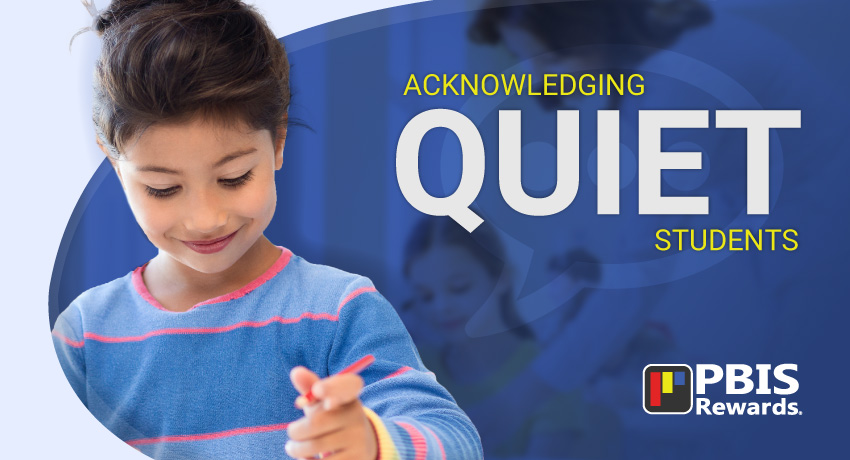Acknowledging quiet students can change the dynamics of your classroom in profound ways.
When Susan Cain’s book, Quiet: The Power of Introverts in a World That Can’t Stop Talking was published in 2012, it opened up a deep and lengthy discussion regarding individuals who are on the quiet side of the introversion-extroversion scale.
Quiet and/or shy students are nothing new in education. Teachers have had quiet individuals in their classrooms as long as there have been classrooms. However, quiet students are often overlooked when the focus is on teaching positive behavior.
The Quiet Student in the Classroom
Researchers suggest that introverts make up anywhere from 16% to 50% of the population. Why such a broad range? Introversion exists on a spectrum. There are varying degrees of introversion and there are relatively few pure introverts or extroverts. Students who align more closely with the introvert side of the spectrum are often those quiet students in a classroom.
More outgoing students get the lion’s share of a teacher’s attention, and the American system of education seems to value extroversion. But in many ways, quiet students are a teacher’s dream. They stay on task, don’t disrupt the class, and can be depended upon to complete classwork. Because quiet students don’t draw attention to themselves in the same way loud or expressive students do, there is potential for them to go unrecognized for exhibiting positive behavior.
Why Students Are Quiet
It’s not only introverts who can be quiet students. In a classroom of 25 to 30 individuals, there are likely a few students who are quiet for other reasons, including:
- Cultural differences
- Lost in the material
- Different learning styles
- Personal problems
- Shyness
- Fear of attention/exposure to others opinions/failure
- Social anxiety
- Fear of being “shut down” or experience with being shut down
- Lack of confidence
Whatever the reasons, quiet students may be overlooked when PBIS points are awarded. More expressive students can rack up points for such actions as raising their hand when they have something to say or taking turns during an activity. But quiet students may not be as apt to participate in classroom activities.
If your PBIS program’s behavior expectations don’t include “quieter” skills such as working independently, following directions or listening carefully, quiet students can feel excluded. Acknowledging quiet students for the things that are part of their disposition can help them to build points just as quickly as your more active and outgoing students.
Acknowledging Quiet Students
Educators who view introversion as a character flaw to be “fixed” often push such individuals into uncomfortable territory. While some students thrive in a lively classroom, others feel left out. Basing a part of the overall grade on class participation penalizes quiet students unnecessarily. This is why acknowledging quiet students can level the playing field for the entire class.
Understand that not every student participates by speaking up in class. Often, these students can strengthen class discussion and understanding if allowed to participate in other ways.
Strategies for Drawing Out Quiet Students
While a certain amount of discomfort is part of learning, there are gentle ways to draw out the potential of quiet students.
- Build quiet time into the class period – Students who are quiet are often thinking very deeply about the topic at hand. Give the entire class time to process the material.
- Open up a class discussion on social media – Some individuals find it easier to express themselves using a keyboard instead of speaking up. Using social media can help to draw these students into a deeper discussion outside of class time.
- Think-pair-share – Provide a discussion question and pair up students to discuss it. The students share the collaborative conversation with the class as a whole.
- One-on-one – Many quiet students loathe having the attention of the entire class. Taking time outside of class to ask them, “what do you think” gives them the opportunity to share their thoughts and feel validated. Some students don’t realize that not everyone has the right answer and it is okay to bring an idea forward for consideration. This can help to build confidence for in-class discussions.
- Small group discussions – In a classroom with more outgoing personalities, quiet students are hesitant to add their voice to the discussion. Take some of the pressure off by breaking the class into small groups for discussions.
- Teach respect – Outgoing students can dominate a class discussion. Allowing everyone in a class to have equal time to voice their thoughts can help teach the power of listening.
PBIS Rewards for All Students
An effective PBIS program takes into account the temperaments of all the students when establishing expectations. While more active and outgoing students typically receive points for exhibiting positive behavior, don’t forget the quiet students. Acknowledging quiet students for qualities such as staying on-task and working quietly can help to improve your overall classroom atmosphere.
PBIS Rewards makes it easy to award points for all the expectations you set. Change your classroom and school climate with a schoolwide PBIS program that acknowledges positive behavior in everyone!


